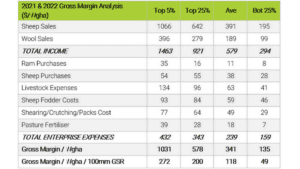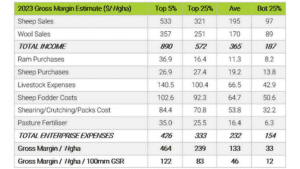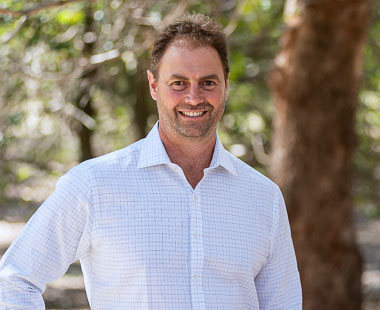Written by: Paul Omodei | Farm Business Consultant | 0427 728 566
Around this time last year I wrote an article referencing a trophic cascade (an ecological process which starts at the top of the food chain and tumbles all the way down to the bottom) and specifically “how wolves changed rivers” in the Yellowstone National Park since their reintroduction in 1995. It basically describes how introducing wolves at the top of the food chain, positively affected the whole river system
in that example. For a good 4 minute listen, here it is again.
My article then went on to reference the results of our sheep benchmarks (2020 and 2021) and the large difference in profitability of over 200 Planfarm clients across the state. This was at a time when sheep prices were indeed at much higher levels than they are now which was reflected in the profitability of the sheep enterprise. At the time, I was encouraging our clients to “think” about whether their sheep
enterprise needed a “wolf” that in time would strengthen their overall sheep system as it was certainly “good times” for sheep back some twelve months ago. In the words of famous Hawthorn coach John Kennedy in the 1975 VFL Grand Final, what I should have said was DON’T THINK, DON’T HOPE, JUST DO!! Unfortunately for Hawks supporters their team lost heavily that day to North Melbourne, but
Kennedy’s speech is etched in history. From John Kennedy’s famous “Do Something” Speech.
Now, hindsight is a wonderful thing, so they say! Arguably those in livestock currently could be forgiven for thinking that the wolf is indeed at the door!! I do not need to explain to you about the significant changes in the livestock industry in the recent twelve months which certainly has us all rethinking and analysing our livestock systems and place in the business. Basically, this time last year has been flipped
on its head! So, let us breathe deep and look at some financial facts.
There continues to be a large difference between the profitability of livestock enterprises across WA. Our recent sheep benchmarking analysis conducted over the past three years continues to show this distinct difference.
Table 1 below summarises the analysis of gross margin of over 200 Planfarm sheep clients across WA for 2021 & 2022 combined. As reported in last year’s article, the key output of this analysis is the gross margin per winter grazed hectare (Wgha) per 100mm of growing season rainfall (GSR) which enables us to compare (fairly), sheep enterprises across different rainfall regions. The eye-opening result here is
the top 25% sheep clients are producing 69% more margin per Wgha per 100mm GSR than the average, and the Top 5% produce 130% more than the average! As an aside, the average adjusted sheep price received by clients was $137/ head and wool price was $8.85/kg greasy for the 2021 & 2022 years combined.
When we dive deeper into these results and look within the individual businesses, it is the livestock system that they run which mainly drives the profitability result. It is not the price per head, or price per kg of wool they receive, but rather the production of them from the pasture and feed resources they produce. They run a productive and efficient livestock system.

Table 1: Sheep Gross Margin Analysis Summary of over 200 Planfarm clients in 2021 & 2022 (combined) across WA.
Understandably, this is all in the past. So, I turn your attention to Table 2 which looks to a forecast (yes this is an estimate only) for 2023. It takes the same set of client data from 2021 & 2022 and overlays the current reality of income and operating costs facing sheep enterprises.
Some key assumptions:
- Sheep sales halved ($68/head vs $137/hd)
- Wool income decreased by 10% ($7.96 vs $8.85/kg greasy).
- Sheep purchases decreased by 50% (in line with 50% decrease in sheep sales).
- Sheep fodder costs increased by 10% (reflecting higher grain prices).
- Pasture fertiliser decreased by 10% (reflecting slight easing in fertiliser prices).

Table 2: 2023 (Estimated) Sheep Gross Margin Analysis Summary using the same Planfarm client’s dataset from 2021 & 2022 (combined) across WA.
The results are very interesting indeed. It is clear and understandable that gross margins are forecast to be significantly lower, and this is a major concern for any business. However, the forecast sheep gross margin in this analysis remains a positive figure for the Top 5% through to the Bottom 25%.
The relevance of this is significant:
- at severely reduced sheep prices and changing operating costs, sheep enterprises can still produce a positive gross margin.
- a positive sheep gross margin contributes to overhead costs in the business.
- exchanging a hectare of sheep enterprise to another enterprise (crop, fallow) needs to ensure that the replacement enterprise contributes a positive gross margin to that hectare of land – otherwise the business is worse off!
- focus should remain on the productivity of the sheep enterprise so that every hectare it operates on can be more profitable. Some easy wins are culling hard now for things like poor udders, poor feet, poor structure, all the things that we potentially forgot about when we thought that keeping everything that could breed a lamb was going to be more profitable.
I certainly think it is time to keep a strong focus within your own fences and indeed between them! What will be your most productive and profitable use of each hectare you own or lease?
So, back to my original question from July 2022:
“Does your sheep system need a wolf?”


